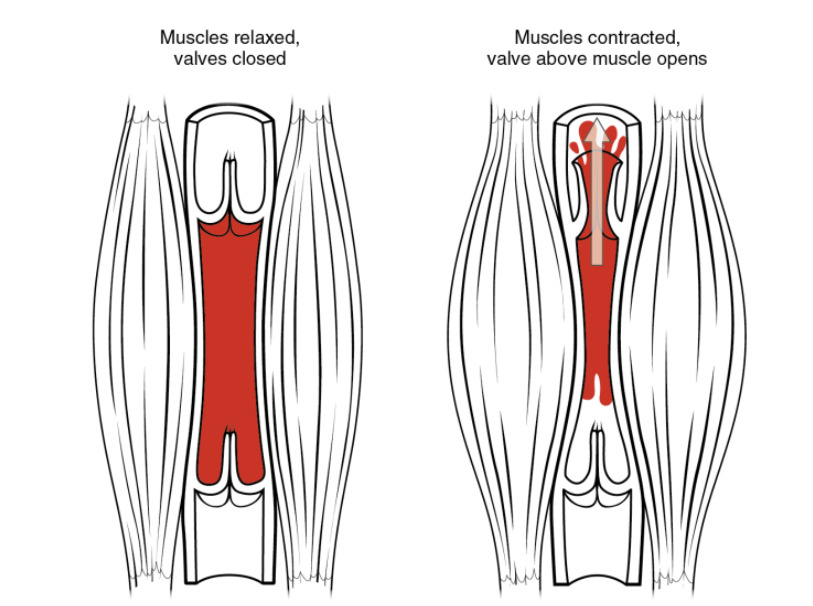Playlist
Show Playlist
Hide Playlist
Skeletal Muscle Pump and Effects of Chronic Endurance Training – CV Response to Exercise
-
Slides CVresponse VascularPhysiology.pdf
-
Download Lecture Overview
00:00 Other things that are helping you return blood to the heart are things like the skeletal muscle pump. The skeletal muscle pump was discussed in the venous lecture but I think it's very important to bring back here. The reason is it's because muscle pumping is occurring so often during exercise. It is actually one of the primary ways you're going to get blood back to the heart is by squeezing those muscles. So during aerobic exercise, let's say you're riding your bicycle, every time you contract your quadriceps and hamstrings you're getting them to squeeze blood and push it back up towards the heart. This contraction-relaxation cycle will just continue until you stop exercising. This, of course, increases fluid return to the central circulation, allows for greater driving pressures across the skeletal muscle. Because muscle blood flow is based upon this delta P phenomenon, a change in pressure across the vascular bed, pressure 1 minus pressure 2. So if pressure 1 is elevated because of an increase in systolic blood pressure and pressure 2 decreases a little bit because you are really pushing that blood back to the heart, you've now set up a greater pressure differential. Finally, you can increase venous return from not only the skeletal muscle pump but also with venoconstriction. If you constrict the veins, you make them less compliant, therefore they're going to have that blood travel through them quicker back up to the heart. There are a number of benefits of chronic exercise and this especially impacts the cardiovascular system and in fact you probably know many of these from your own health and fitness but you can also apply these in clinical conditions in where someone might have something like a previous myocardial infarction, maybe bypass surgery and now what you want to do is increase their muscle function capacity of, let's say, the heart. So what advantages do you have of chronic endurance exercise with variables like heart rate, stroke volume and cardiac output? During resting conditions, heart rates will lower, stroke volumes will be higher but cardiac output will be normal. During maximal exercise, interestingly, maximal heart rate does not really change if you're trained versus not trained but what really does change is your stroke volume. You'll actually remodel your left ventricle and this chamber size will get larger so that you can fill it up with more blood and eject more blood per stroke. That increase both your stroke volume as well as your cardiac output. Besides the heart, there are a number other adaptations that occur with exercise, aerobic exercise. Part of this have to do with facilitating the delivery of oxygen to working muscle whether that be skeletal muscle or the heart. Also to remove carbon dioxide so that you won't have as much CO2 around or potential for acid-base problems. So let's go through and talk through each individual vascular adaptation. One of the most important is there is an increase vascularity in the heart. You have a number of heart blood vessels and we will call that as part of your coronary tree. There is an increase in the amount of cross section of each of these vessels and there is more collateral circulation so you get more blood flow to more cardiac myocytes. The more blood flow they get, the more oxygen can be delivered, the more CO2 that can be removed. There is also a decrease in afterload. 04:10 Afterload is pretty much analogous to a decrease in systemic vascular resistance. What is that? Well that is there's more vasodilation to active muscle meaning that there is less resistance in the system. The other thing that's very nice about this is you have a better ability to shunt blood to areas that you need blood. For example, if you're doing something like riding your bicycle you really need to have a lot of blood flow going to your gut or to your splanchnic system? No. So you're better off shunting that blood to working muscle and if you're aerobically trained you can do that to a better extent. The final thing that's very helpful for vascular adaptations is skeletal muscle capillary size and density. You develop more capillaries around skeletal muscle myocytes and what that does is allow you to deliver more oxygen as well as to remove more CO2, very similar to the adaptation that happen around the coronary tree.
About the Lecture
The lecture Skeletal Muscle Pump and Effects of Chronic Endurance Training – CV Response to Exercise by Thad Wilson, PhD is from the course Vascular Physiology.
Included Quiz Questions
What changes in the cardiovascular system would occur after six months of training in a cycling exercise program?
- Increase in resting stroke volume
- Increase in resting heart rate
- Decrease in maximal stroke volume
- Decrease in maximal heart rate
- Increase in maximal heart rate
Which of the following actively contributes to the return of venous blood to the heart during exercise?
- The skeletal muscle pump
- Increased Afterload
- Increase in size of the left atrium
- Decreased systemic vascular resistance
- Increased inotropy
Which of the following changes occur in the heart of a person doing regular exercise?
- Increase in collateral cardiac vasculature
- Decrease in muscle mass
- Increase in afterload
- Reduction in the number of capillaries
- Decrease in stroke volume
Customer reviews
5,0 of 5 stars
| 5 Stars |
|
5 |
| 4 Stars |
|
0 |
| 3 Stars |
|
0 |
| 2 Stars |
|
0 |
| 1 Star |
|
0 |




